Guangwushan (Guangwu Mountain) Scenic Area is located in the northern part of Nanjiang County, Bazhong City, Sichuan Province, at the border of Sichuan and Shaanxi Provinces. It is a national 5A-level tourist scenic area and a world geopark. The total area of the scenic area is 830 square kilometers, with the core scenic area covering 410 square kilometers. Featuring unique ridge and peak cluster landforms, pristine original vegetation, charming waterfalls, ponds and beautiful waters, as well as graceful canyon scenery, the scenic area is known as a "biological gene bank and a natural oxygen bar". The forest coverage rate here reaches 97%, the excellent air quality rate is over 90%, and the average content of negative oxygen ions in the air exceeds 30,000 per cubic centimeter.
History and Culture
As early as the Proterozoic Era, about 2 billion years ago, the area where Guangwushan is located was an ancient marine environment, where a large amount of carbonate rocks (such as dolomite and limestone) were deposited to form the basement rock formation. By the Sinian Period (about 680 million to 541 million years ago), the Dengying Formation dolomite here was gradually formed, laying the foundation for the subsequent development of karst landforms. Today, landscapes in the scenic area such as the Taiji Tiankeng (an "S-shaped" river channel formed by groundwater dissolution and surface water downcutting) and cave groups all originate from the rock formations formed during this period.
In the late Xia Dynasty and early Shang Dynasty, the Ba people blazed trails through the grass in the Guangwushan area, creating the Micang Ancient Road, one of the three major ancient Shu Roads, and initiating the civilized development of the Guangwushan region. The Ba people left a unique cultural mark here; their way of life, customs and habits were integrated into the local historical context, becoming an important source of Guangwushan culture.
The Micang Ancient Road is named after crossing the Micang Mountain. Together with the Jinniu Road and the Litchi Road, it is known as the "Three Major Ancient Shu Roads in China". It was an extremely important military passage and a major transportation route for grain and materials in Chinese history. Extending northward through Guanzhong to the Central Plains and southward through Bashu to the southwest, it connects the past and the present. Historical stories such as "Xiao He chasing Han Xin under the moonlight" and "Zhuge Liang training troops in Muyang City" all took place on this ancient road, making it a "living fossil" carrying rich historical stories and cultural connotations.
The folk culture in the Guangwushan area is rich and colorful. Among them, the Bashan Bei'er Song, which has been sung for thousands of years, has been listed as a national intangible cultural heritage. In addition, there are other intangible cultural resources such as Cuantan Opera and the Ba people's papermaking technique.
Major Scenic Spots
Shudao Qinguang (Sichuan-Shanxi Pass on the Shu Road)
It is the north gate of the Guangwushan Scenic Area and the boundary between Sichuan and Shaanxi Provinces. Since the Qin and Han Dynasties, it has been an important pass for entering and exiting Sichuan and Shaanxi. There were once pass walls and platforms built here, and its ancient name was "Tianshang" (Heavenly). Later, it was restored and renamed "Shudao Qinguang".
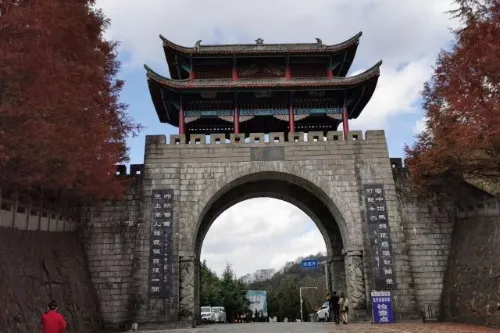
Micang Ancient Road
Named after crossing the Micang Mountain, it is known as one of the three major ancient Shu Roads in China together with the Jinniu Road and the Litchi Road. Hailed as a "living fossil in the history of transportation in China and even the world", it was an extremely important military passage and a vital transportation route for grain and materials in Chinese history.
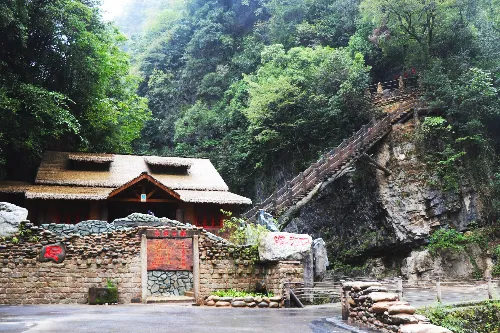
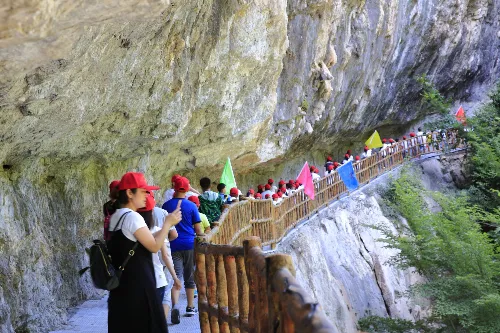
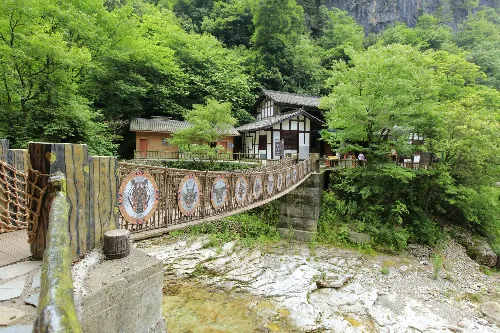
Feiyun Plank Road
Located on the cliff of Taiji Tiankeng, it is marvelous, precipitous and offers a broad view. As it is a circular tourist route, you can choose to go up the mountain from Taiji Tiankeng and then go down from Ganling Temple.
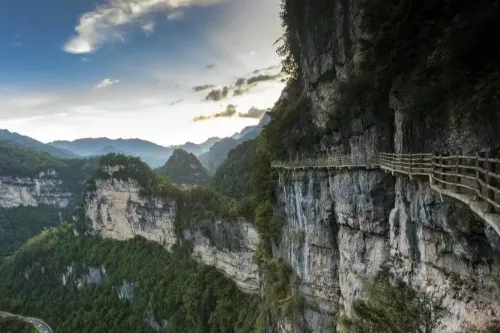
Yanyan Stone Forest (Swallow Ridge)
There is a Swallow Cave under the north cliff of Yanyan Peak. Every spring, thousands of swallows come here to inhabit, hence the name Swallow Ridge. Standing on the viewing platform, you can see stone forests standing in formation all around, with ancient pines and old vines thriving luxuriantly. The canyon cliffs, shaped like being cut by knives and axes, present a variety of fantastic scenes.
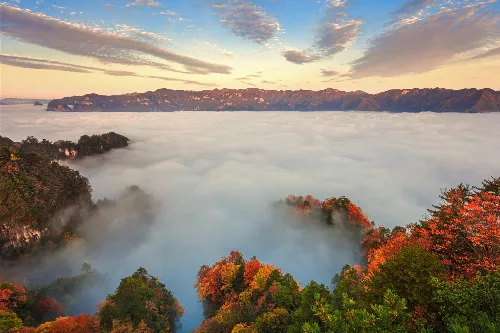
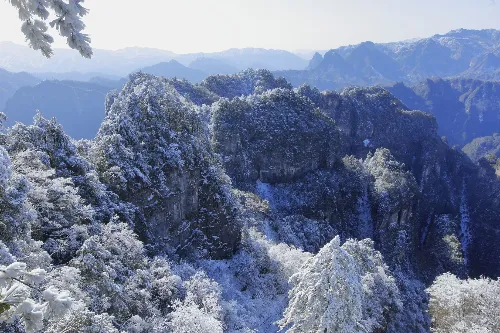
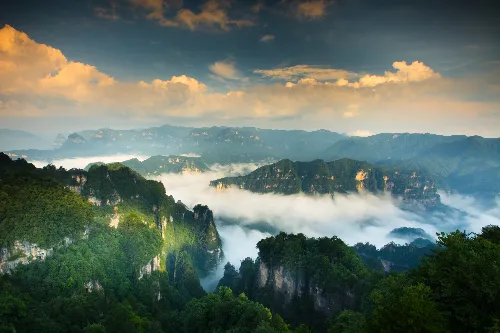
Qinü Peak (Seven Maidens Peaks)
Located near Swallow Ridge, the seven peaks stand gracefully like fairy maidens, exuding extraordinary charm. Fei Xiaotong, the former Vice Chairman of the Standing Committee of the National People's Congress, inscribed the phrase "Guangwushan, a Fairyland on Earth" right here.
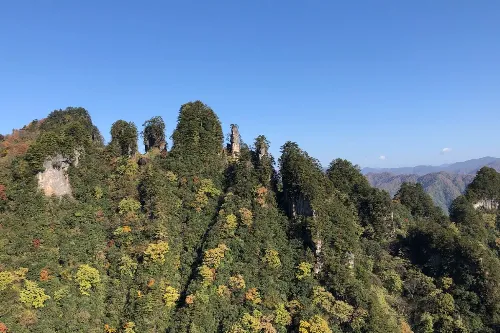
Wanhu Chaosheng (Thousands of Tablets Paying Homage)
Located 500 meters east of Swallow Ridge, a tall stone peak nearby stands like a giant human figure sitting on the cliff. Below, in Huoshitang, stone forests and peak clusters are scattered all over in an orderly manner, just like "thousands of tablets paying homage".
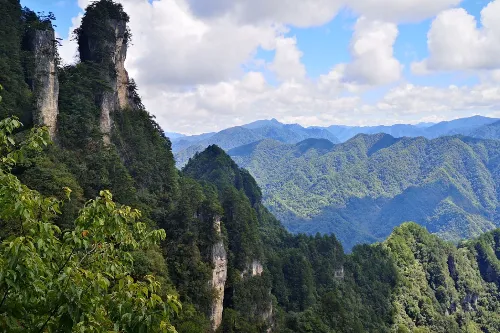

Longjia Yanyun (Dragon-driven Clouds and Mist)
Longjia Mountain rises abruptly from the bank of Jiaojia River, lying horizontally between the green water and the blue sky. It is often wrapped in clouds and mist, appearing and disappearing. The mountain shape resembles a giant dragon's skeleton, divided into upper, middle and lower layers.
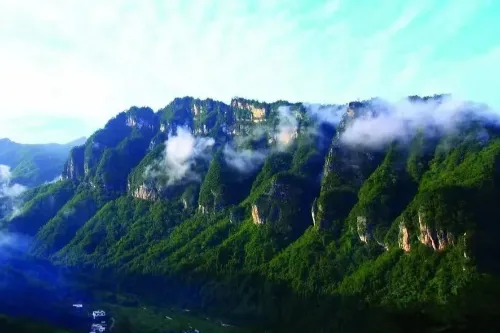
Taiji Tiankeng
It is not a tiankeng in the geological sense, but an arc-shaped curved river channel formed by the combined action of groundwater dissolution and surface water downcutting. The Jiaojia River cuts the karst mountains into an S-shape, which resembles the Taiji pattern, hence the name "Taiji Tiankeng".
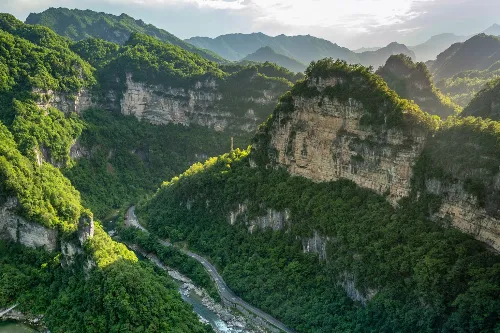
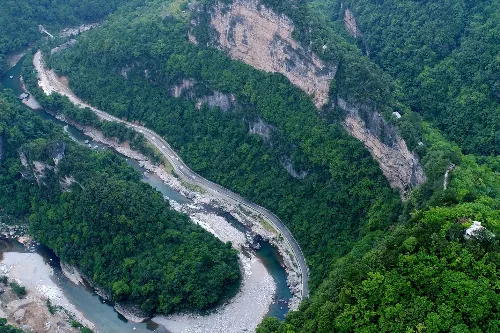
Tour Routes
The following are some common tour routes:
- Route 1: Nanjiang (or Hanzhong) — Guangwushan Town — Longjia Yanyun — Pengjiaba — Sandao Pass — Nantianmen — Qinü Peak — Swallow Ridge — Wanhu Chaosheng — Yanyan Stone Forest — Cherry Canyon — Jiexian Post — Hanxi River — Lianghekou — Taiji Tiankeng — Ganling Temple — Return to Nanjiang (or Hanzhong).
- Route 2: Nanjiang (or Hanzhong) — Guangwushan Town — Longjia Yanyun — Pengjiaba — Lianghekou — Taiji Tiankeng — Feiyun Plank Road — Ganling Temple (suitable for tourists with the elderly and children).
- Route 3: Guangwushan Scenic Area — Nuoshuihe Geopark Museum — Bashan Guerrilla Memorial Hall + Tour Route (choose either Guangwushan or Micang Mountain for combination) + "Dreamlike Guangwushan" (a performance).
Travel Tips
- Pay attention to the weather forecast in advance and prepare clothes and equipment according to the weather conditions.
- The distance within the scenic area is relatively long; it is recommended to wear comfortable hiking shoes or mountaineering shoes.
- Bring sun protection products such as sunscreen, sun hats and sunglasses.
- Choose a suitable tour route based on your physical strength and time to avoid an overly tight schedule.
- If you want to watch the sunrise and sea of clouds, you need to book the early cable car in advance and learn about the relevant precautions beforehand.
Precautions
- Guangwushan has a relatively high altitude, and the temperature difference between morning and evening is large; please bring warm clothes.
- The weather in the mountainous area is changeable; it is recommended to bring rain gear.
- The ecological environment in the scenic area is fragile; do not litter and take good care of the vegetation.
- Pay attention to your footing when climbing, follow the scenic area regulations, and do not climb into unopened areas at will.
- If you encounter wild animals, do not attempt to touch or feed them.
- Respect the local cultural traditions and customs.
Transportation
- From Chengdu:
- Passenger Bus: Chengdu (it is recommended to take the bus at North Gate Bus Station) — Nanjiang (it is recommended to take the bus at Guangyun Bus Station) — Guangwushan Scenic Area & Micang Mountain Tourist Scenic Area.
- High-Speed Railway: Chengdu East Railway Station — Hanzhong (it is recommended to take the bus at Hanzhong Passenger Transport Hub Station / Hanzhong Automobile Transportation Corporation Bus Station) — Guangwushan Scenic Area & Micang Mountain Tourist Scenic Area.
- Regular Train: Chengdu East Railway Station — Bazhong (it is recommended to take the bus at Bazhong Jiangbei Passenger Transport Center Station) — Guangwushan Scenic Area & Micang Mountain Tourist Scenic Area.
- Self-Driving: Chengdu (Chengdu-Bazhong Expressway) — Bazhong (Bazhong-Shaanxi Expressway) — Qiaoting (exit the expressway) — Guangwushan Scenic Area & Micang Mountain Tourist Scenic Area; or Chengdu (Chengdu-Bazhong Expressway) — Bazhong (Bazhong-Shaanxi Expressway) — Nanjiang North (exit the expressway) — Yangba — Xinmin — Shibayue Lake Scenic Area.
- From Chongqing:
- Passenger Bus: Chongqing (it is recommended to take the bus at Caiyuanba Bus Station) — Nanjiang (it is recommended to take the bus at Guangyun Bus Station) — Guangwushan Scenic Area & Micang Mountain Tourist Scenic Area.
- High-Speed Railway: Chongqing West Railway Station / Chongqing North Railway Station — Hanzhong (it is recommended to take the bus at Hanzhong Passenger Transport Hub Station / Hanzhong Automobile Transportation Corporation Bus Station) — Guangwushan Scenic Area & Micang Mountain Tourist Scenic Area.
- Regular Train: Chongqing North Railway Station — Bazhong (it is recommended to take the bus at Bazhong Jiangbei Passenger Transport Center Station) — Guangwushan Scenic Area & Micang Mountain Tourist Scenic Area.
- Self-Driving: Chongqing (Chongqing-Guangyuan-Chengdu Expressway) — Bazhong (Bazhong-Shaanxi Expressway) — Qiaoting (exit the expressway) — Guangwushan Scenic Area & Micang Mountain Tourist Scenic Area; or Chongqing (Chongqing-Guangyuan-Chengdu Expressway) — Bazhong (Bazhong-Shaanxi Expressway) — Nanjiang North (exit the expressway) — Yangba — Xinmin — Shibayue Lake Scenic Area.
- From Xi'an:
- Passenger Bus: Xi'an (it is recommended to take the bus at Xi'an West Bus Station / Xi'an South Bus Station) — Hanzhong (it is recommended to take the bus at Hanzhong Passenger Transport Hub Station / Hanzhong Automobile Transportation Corporation Bus Station) — Guangwushan Scenic Area & Micang Mountain Tourist Scenic Area.
- High-Speed Railway: Xi'an North Railway Station — Hanzhong (it is recommended to take the bus at Hanzhong Passenger Transport Hub Station / Hanzhong Automobile Transportation Corporation Bus Station) — Guangwushan Scenic Area & Micang Mountain Tourist Scenic Area.
- Self-Driving: Xi'an (Xi'an-Hanzhong Expressway) — Hanzhong (Bazhong-Shaanxi Expressway) — Xishenba (exit the expressway) — Guangwushan Scenic Area & Micang Mountain Tourist Scenic Area; or Xi'an (Xi'an-Hanzhong Expressway) — Hanzhong (Bazhong-Shaanxi Expressway) — Nanjiang North (exit the expressway) — Yangba — Xinmin — Shibayue Lake Scenic Area.
Opening Hours
Regular opening hours are 8:00-22:00. Please refer to the actual opening hours of the scenic area for updates.
Tickets
Ticket + Sightseeing Bus: CNY 115 per person.
You can search for the official WeChat public account of the scenic area "玩转光雾山" to get the latest updates or book tickets online.
Online Booking
Click here to jump to the Trip.com ticketing platform for ticket purchase.


